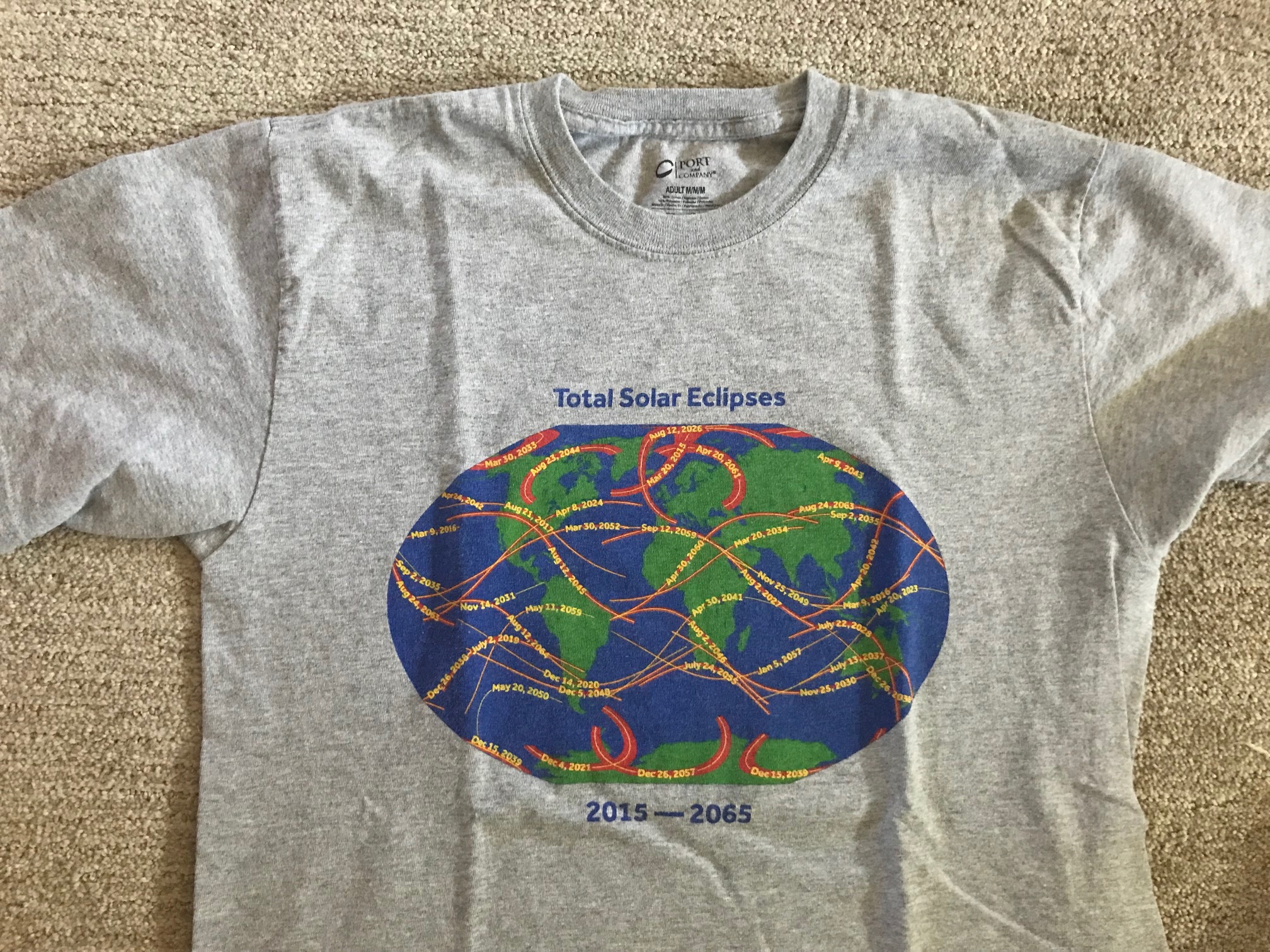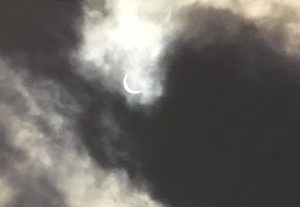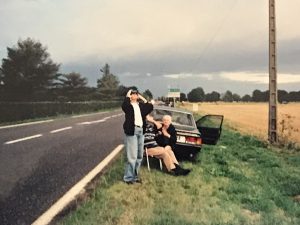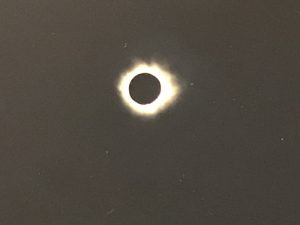
The guilty truth is that I am an eclipse-chaser, admittedly an expensive and indulgent thing. I can claim that I am just along for the ride, but I go willingly, so that isn’t really an excuse.
Okay. We were definitely eclipse-chasers now.
There has always been a bit of astronerd in me. How could you not be intrigued by the enormity of the universe and how things work—physics, relativity, chemistry, biology, the genetic code, the periodic table? I toyed with the idea of being an astronaut–abandoned early on—but still chose introductory astronomy (Nat Sci 9) as my required science in college.
I remember looking out the window one night when I was in grade school in Michigan, and thinking how strange the moon looked, all orange. And later it looked normal again. My first lunar eclipse, I later found out. In 1972, I saw my first solar eclipse from the steps of an MIT building where people had gathered with special protective glasses. Pinhole image projectors made from a perforation in a piece of cardboard, fingers held closely together, or even leaves of trees, created shadow crescent suns on the pavement or paper. The eclipse was only a deep partial in Cambridge, but it was total off the coast of Nova Scotia (as per Carly Simon’s song “You’re so Vain”).
Much later, in 1994 in Oakland, there was a view of another partial solar eclipse, but it was far from total; most eclipses paths are over water, since that makes up most of the Earth’s surface, and often are nowhere near where you are. But in 1999, a total solar eclipse was slated to cross most of Europe and the Middle East, where a huge number of people could see it. We were already planning to go to a family reunion in Europe around that time, so add on a few days and maybe we’d be in luck.
The weather was not cooperating over most of Europe. That was bad, since you can’t see the eclipse through dense clouds and rain, though it will get dark. Most people were disappointed that day. We pored over the weather reports searching for a break; it looked as if there might be some chance in northwestern France, so we hazarded driving in that direction, only to find that all the rooms near the path of totality were booked up. We lucked into a place near Falaise, birthplace of William the Conqueror, though a distance from where we needed to be. So, early the next morning, we headed northward, referring to giant fold-up Michelin road maps. As we raced to reach the path in time, every few minutes I would look out the car window with welder’s glasses and report on the narrowing crescent sun peeking through the clouds. At last, we hoped we were close enough and pulled off the road by a field, where a few others had stopped–soon to be joined by others who perhaps thought we knew what we were doing.
Looking up, we could just see the last sliver of sun through breaks in the clouds, the light got very strange, and it was definitely darker and colder. And then in an instant, there was a brief flash, and everything changed. Where there had been light, there was an exact, round, pitch-black hole in the sky, with a halo of corona around it. The field erupted in cheers and cries of “ooh la la la la la la”, everyone at once. It was surprisingly emotional. It contradicted what we tacitly understood as normal, while the true spatial relationships of the earth, moon and sun were revealed in breathtaking clarity.
And all too soon, totality was over, leaving behind the big question: When is the next one?
The following year, Sally got a “go-to” telescope for her fiftieth birthday, and we brought it on a camping trip to Baja California. For its inaugural observation, we hauled it out at the beach at Pabellon, north of Guerrero Negro, with the Pacific Ocean to the west and the desert to the east—and a completely clear and dark sky. Magical. However, we were so far south and the sky so full of stars that we could hardly identify the ones we needed to calibrate the instrument.
On return, we started going to adult classes at the Chabot observatory to learn the night sky. Ryan would maneuver the planetarium’s Zeiss projector to teach us how to star-hop. After each session we got to look through the historic 20 inch “Rachel” and 8 inch “Leah” refracting telescopes, and “Nellie”, the new 36 inch reflector scope. When the 2001 total solar eclipse passed over Zambia, Chabot live-streamed it on their big screen. Not quite the same as being there though.
And so, in 2002, when there was a chance to see the tail end of a very short eclipse in Australia, we found a way to get there. This was in spite of my boss’s wrath, who didn’t want me to take so much time off (though I had it on the books)—he thundered that I was never to do that again! But we needed all that time for our journey to the other side of the world and no regrets. We camped our way across to the edge of the outback at Lyndhurst, where the Strzelecki Track and Oodnadatta Track intersect, and an eclipse rock festival was underway. We set up a few miles away, overlooking an ancient aboriginal ochre mine of many colors, and were treated to an astounding, sparkling 27-second eclipse with brilliant chromosphere, prominences and corona low in the sky, followed by the crescent sun sinking below the horizon.
Okay. We were definitely eclipse-chasers now.
Since then, we have continued to learn about the night sky and the universe, enjoying comets, meteor showers, aurorae, and deep sky objects through various scopes. Eclipses have been the excuse for more trips than I like to admit, to places we would not otherwise have thought to go, and we have observed from land, sea, and air. We have met fellow eclipse-chasers, and I have written eclipse songs for most of them. We can bore friends with the details of eclipse mechanics, but only if they insist. Technology has made planning much easier, and there is even an eclipse tour industry. And since you can’t guarantee success if weather doesn’t cooperate, you might as well plan a darn good trip around it.
COVID and climate change have affected future travels, but in 2024 there is another eclipse crossing the U.S. and probably near enough to you. Don’t miss it.
.






What a wonderful hobby Khati!
Reading your story reminds me of a wonderful guy who was a member of an amateur astronomical society and would set up telescopes and give informal night sky lessons in our neighborhood Carl Schurz Park. He hooked my then young son who’s had a telescope ever since.
I also remember a trip to South Africa and experiencing the beauty of a starry night sky without the light pollution of a New York City sky!
Those sound like wonderful experiences, and one of the joys of amateur astronomers is sharing the wonder with others. With so much light pollution, many people have never really seen a dark sky and all that it holds, but people through the ages have been more attuned. Tracking the heavens was a basis of myth and science both. Very cool. And humbling.
Great hobby, Khati. Very cool to learn so much about the sky and what goes on it in and to literally chase down an eclipse, as you describe. My older child loved everything about the universe too and I took the kids out comet searching (I think it was Hale-Bopp) one evening. We had to drive quite far out to get away from light pollution, but it was worth it.
We have been lucky to have some great comets come through, and worth the effort. Sometimes people also don’t realize how much you can see with a simple pair of binoculars—more stars and nebulae and moon features than you would imagine.
Yes!!!
Marvelous, Khati. There is something primal about eclipses of all kinds. Recently there was a lunar eclipse visible in northern California. Even though I’m not as adventurous as you, I sometimes have access to telescopes set up by friends, and it’s amazing what you can see in the night sky. Thanks for an inspiring story.
It is easy to forget how much you can see if you look 🙂 Enjoy.
What a fantastically unique hobby, Khati. And a whole lot safer and saner than tornado chasing. Even though I recall my high school physics teacher dismissing eclipses as “nothing more than astronomical coincidences,” I, too, have always been intrigued by them. But I am afraid I’m just too sedentary to chase them, as you have brilliantly done.
I also love your title. As mentioned in one of my comments, I consider “nerd” to be a badge of honor, so wear it proudly.
“Nerd” has become more respectable in our cyber-age too! There is definitely a huge overlap in people who chase storms, follow weather events, seek aurora, and chase eclipses. You are correct that eclipses count as Astro-tourism of a coincidence-the moon is just the right size and distance to cover the sun for dazzling effect—but is still undeniably a sight, so it’s okay to sightsee. A wonder of nature like a waterfall or spectacular scenery, but an even grander scale. Coming to a state near you soon.
What a fascination hobby, Khati. My husband is really into eclipses but we have never traveled to see them. I am getting him a telescope for his birthday because we now live on the 14th floor of a condo with balconies and he will be able to see much more of the sky. I’ll put 2024 on the calendar!
Absolutely! In the US, 2024 swings from Texas up through Illinois and off over Niagara Falls. Or you can go to Mazatlan. And don’t forget to use the binoculars for the night sky. “Nightwatch” by Terrence Dickinson is perfect for learning what is up there.
Fabulous story, Khati, and great photos!! I actually got emotional as I read your story and got to the photo of the pitch-black hole in the sky. Have you read Annie Dillard’s story “Total Eclipse”? Worth reading, if you haven’t already…or re-reading, as I just did.
My husband was an astrophotographer for a while. I’ll never forget the time when we were first dating and on a camping trip, he pointed to a blur above and just to the right of a pine tree, then handed me binoculars and that blur exploded into…the Andromeda galaxy! Talk about rocking my world! We’ve since been to several observatories, including the Chabot, where we had a chance to admire that lovely little 8″ Leah telescope up close.
Kudos to you for chasing eclipses…you continue to blow my mind!
Thanks for the recommendation on Annie Dillard’s story–did not know of it. We have some friends who are spectacular astrophotographers–digital imaging has advanced to make amateurs into mini-Hubbles–and you can appreciate how pointing optical equipment at the sky can yield so much. Galileo would be amazed. The Andromeda galaxy is the one thing you can see in the sky with the unaided eye, which is NOT in our Milky Way, and simple binoculars turn a little blob into so much more. Actually seeing the rings of Saturn (and yes, they are really there) through a decent telescope is not to be forgotten. Good to know you have also enjoyed Chabot–it is definitely a local gem.
Yes, I have seen the rings of Saturn, too, through a telescope in my own backyard…and somehow so astonishing no matter how many pictures you might have seen!
Here’s a link to Garth’s site in case you’d like to see some of his photos: http://www.garthbucklesphotography.com/index.htm
Saturn is a real show stopper—hard to believe those rings are really there and you can see them yourself. Thanks for the link to Garth’s pictures—they are amazing. So many stars and great resolution, and the colours too. What a treat.
It’s great to hear that you are a nerd and interested in astronomy. I wanted to badly to get a decent telescope when I was a kid, I drooled over the Edmund Scientific catalog and tried to convince my dad to get me the 4-1/4 inch reflector with the equatorial mount. I knew I never could convince him to go for the 6-inch scope. At Christmas that year, I opened my “big” gift and found that he had instead bought a cheap telescope from Sears, with a mirror made of shiny aluminum and a ball and socket mount. The “finder” was just an aluminum tube. You could point the scope at an object in the sky, but without a proper mount, you couldn’t really follow it. Nevertheless, I did manage to see little bulges on the side of Saturn and the face of Jupiter.
Fast forward to last year, when a friend in our neighborhood told me that he had helped out a friend by buying a 1998 vintage Celestron-8 scope with a fork-type mount, and would sell it to me for $550. I bought it and since then I have upgraded the mount to a computerized AV-X equatorial mount with which I can find any object out of a catalog of thousands. I have also joined the Cape Fear Astronomical Society and with the help of the members I am beginning to learn much more about how to use the equipment.
It sounds like your well-intentioned parents got you a classic “trash” telescope, which has probably discouraged far too many young people (who would have done better with decent binoculars). So glad to hear you have a better toy to play with now, and a group to support your efforts. It makes such a difference! When we got a “go-to” scope it was great, but realized you had to know enough about the stars to get it aligned before it would go to the right place ha ha. No GPS. Wishing you clear skies and dark nights.
Khati, I am an eclipse-chaser too, as I think you know, so I thoroughly enjoyed your story. In July 1991, I actually flew to Baja California for the day just to see an eclipse, and it was truly spectacular. Your description of the one you saw in France was exactly like what I experienced in Mexico. And my biggest disappointment in the pandemic was being unable to go on my bought-and-paid-for trip to Chile in December 2020. We are already planning for 2024, so would love to compare notes with you.
Yea, I did remember you also are an eclipse chaser. You understand. Just like you, we had to cancel a trip to Chile last year—we were planning to be near Villarica for the eclipse but of course no dice. It would have been fun to cross paths. The weather was not very cooperative as it turned out, but still. A couple of years ago we bought into an Antarctica trip for the December 4 eclipse, which has still not been canceled, so fingers crossed for that one. Still working on where to be in 2024, though Texas is possible as we have friends there. Mazatlan is tempting. Watch this space 🙂
How exciting! Thanks for your story, and great to read about your adventures chasing the eclipses. My first total solar eclipse was in 1979, viewed from Goldendale, Washington. It was a cloudy day, but the clouds parted at just the right moment. Also saw the one in Baja. It was amazing for the clear skies and the six-plus minutes of totality. There was an annular eclipse (with the moon too far from the earth so totality didn’t occur which I was able to see about 50 miles north of Sacramento. And you and I shared the 1972 eclipse which I saw at 99% totality from West Point, NY. The one in Oregon in 2019 was my latest. Very short, but very satisfying. There’s something truly magical when the sun disappears and the corona comes out.
I’m sure you’re looking forward to 2024 which should also be amazing.
Sometimes drama of whether or not the clouds will clear adds to the experience—but only when they finally part! We saw an annular eclipse from a rest area outside Winnemucca in 2012–maybe the same one you saw from Sacramento. Also very cool, especially through a hydrogen alpha scope for solar viewing, but not the pop of totality. We were in eastern Oregon (Farewell Bend State Park) for 2017, great because so many friends could join in! May we all have clear skies in 2024.